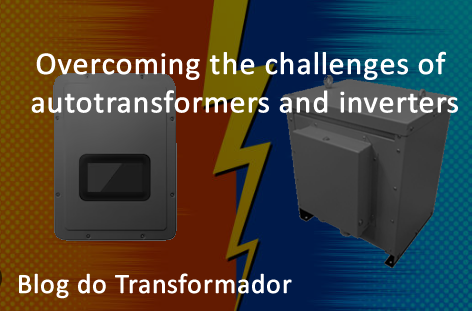
An electric autotransformer, also known as a voltage transformer, can be used in a solar power generation system to adjust the voltage of the electricity produced by the PV panels before it is sent to the grid. The voltage level of the electricity generated by the PV panels is often different than the voltage level of the electricity that is sent to the grid. By using an autotransformer to increase the voltage, the amount of electricity that can be transmitted over a given distance is increased, which can reduce the cost and complexity of the transmission infrastructure. Autotransformers works by adjusting the voltage level of the electricity through a process known as voltage transformation. It does so by only having a single winding that is tapped at different points. The input voltage is applied to one end of the winding and the output voltage is taken from a different point on the same winding. This allows for a smooth and continuous adjustment of the voltage level without the need for multiple windings or multiple transformers.

The autotransformer is connected between the PV panels inverter and the grid connection point, typically at the utility substation. The autotransformer uses a step-up/step-down winding ratio to adjust the voltage to the level required by the grid and is connected to the grid through a switchgear. The switchgear, along with protection and control devices, allows the grid operator to control the flow of electricity from the solar power generation system to the grid. It is important to note that the use of autotransformers in solar power generation is dependent on the specific characteristics of the system and regulations of the country. It is best to consult with experts on the design and implementation of such systems.

Inverters used in photovoltaic (PV) systems typically convert direct current (DC) electricity generated by the PV panels into alternating current (AC) electricity, which is the type of electricity used in most homes and buildings. This allows the electricity generated by the PV panels to be used directly by the building or sent back to the grid for use by others. Inverters also typically include features such as maximum power point tracking (MPPT) to optimize the power output of the PV panels and grid-tie functionality to allow the system to connect to the utility grid. One of the key technologies used in inverters to accomplish this is called pulse width modulation (PWM) which simulates a sine wave output by rapidly switching the DC voltage on and off.
PWM inverters use a high-frequency switching circuit to generate a square wave, which is then filtered to produce a waveform that is similar to a sine wave. This process creates a simulated sine wave that is used to drive the AC load. The PWM inverter has several advantages such as high efficiency, fast response time, and low harmonic distortion. However, there are also some limitations to this technology.
One of the main limitations of PWM inverters is that they can generate harmonic distortion, which can cause problems for devices connected to the inverter. Harmonic distortion is caused by the non-sinusoidal nature of the PWM waveform, which can create higher-frequency components that can interfere with sensitive electronic devices. Additionally, PWM inverters can also cause issues such as motor heating and bearing wear in motor-driven systems.


Sometimes it can be difficult to determine the cause of the burnout of some component of the solar generation system, but by making a more careful analysis with an oscilloscope, it is possible to determine whether the behavior of the inverter is consistent with the phenomena that occur in the electrical grid.
This could be the origin of the problem of equipment or the autotransformer itself burning, without even activating any protection, since the harmonics are generated in short peaks that end up not acting on the protections, but accumulating problems that can damage other components of the circuit, such as for example the autotransformer.
For this reason, it is also important to know if the inverter actually supports or filters such interference so as not to compromise the generation or any component of the circuit.
Another limitation is the high-frequency switching circuit in the inverter can cause electromagnetic interference (EMI) which can cause problems for other electronic devices or communication systems nearby.
Furthermore, the PWM inverter can also cause problems in the presence of certain types of loads, such as non-linear loads or loads with high harmonic content. These loads can cause additional harmonic distortion in the output waveform, which can lead to further problems with connected devices.
Overall, PWM inverters are a reliable and efficient solution for converting DC to AC, but it is important to consider the limitations and potential issues when designing a PV system and connecting devices to the inverter. If a system requires a high-quality sinusoidal waveform, it is better to use a sine wave inverter instead.
In the ILTECH INNOVATIVE TRANSFORMERS we help customers around the world with the right project for specific requirements and software for the most variety of electric transformers projects to improve the efficiency and reduce costs of process. To know more you can visit SISRECWEB.
